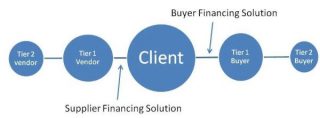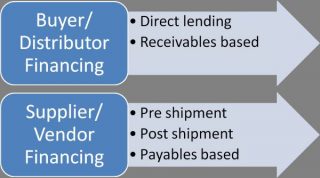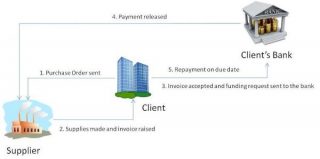
What is Supply Chain Finance and how does it work?
Supply Chain Finance was created to provide a reliable, quick and tailored financing solution that may be applied across a company’s entire supply chain.
How Supply Chain Finance differs from other traditional forms of financing is that it is usually in the shape of a consistent template that once structured, may be applied to all channel partners in an expedited fashion. Different banks have slightly varying implementations of Supply Chain Finance (SCF) but the essential element remains the same, funding a client’s buyers and sellers.
A simplistic view of Supply Chain Financing
Who is eligible?
Banks usually tailor SCF around their most reliable customers- clients who are the market leaders in their respective businesses or regions. However, the benefit of SCF is that funding is made available to the smaller buyers and sellers of that client based on the strength of their relationship. This allows for cheaper funding, with less or no collateral, better control mechanisms and various other benefits.
SCF may be applied across a company’s entire supply chain. This would include suppliers (goods or service providers) and buyers (distributors, manufacturers, etc.). It extends up to Tier 1 channel partners, but many banks now offer Tier 2 channel partners the facility as well, depending on how strong the supply chain links are.
How is it implemented?
A Supply Chain finance solution is centered around a particular client and specifically tailored by his Bank to his specific requirements. Once a full template has been agreed upon, the Bank would approach the customer’s buyers and suppliers with a detailed description of the solution and aim to onboard these channel partners into the Supply Chain Platform. Since the Bank has a fair idea already about the strength of the Supply Chain, they can usually offer higher exposures and better pricing to these channel partners.
What are the Product offerings?
From a product perspective, Supply Chain Financing may be offered in various forms. Again, different Banks may have different terminology for their particular product offerings, but the essence remains the same.
Buyer or Distributor Financing is an attractive and fast-growing product. In addition to the traditional receivables based option, now many of the larger Banks offer direct Supply Chain loans to the Buyers. A large corporate may have hundreds or even thousands of domestic and international buyers. Funding these clients gives banks the option to increase their customer base while helping the client to manage their sales in a predictable manner.
Some standard Supply Chain Finance products
Supplier/ Vendor Finance also takes different forms. The post-shipment approach is the most common where funding is released based on accepted invoices. This provides the Bank with an additional comfort and usually allows for collateral-free lending. Another great advantage of this is that the various options allow for differing accounting treatments- which can help a client deleverage their Balance Sheets.
How does it work?
There are various mechanisms and variations followed by different Banks for different product categories. Let’s illustrate with the help of one example here.
A post shipment, post-acceptance invoice financing product
Step 1: Client issues a Pay Order to their supplier for some raw material
Step 2: The supplier makes the shipment when ready and sends an invoice
Step 3: The client accepts the invoice and sends a funding request to the Bank (with the supplier’s concurrence or the request may be raised by the supplier directly as well based on the accepted invoice)
Step 4: The bank’s release the payment to the supplier
Step 5: On the due date, the client makes the payment to the Bank, thus offsetting the loan and finishing the transaction
This simplistic example gives an idea of the transaction flow for a typical SCF transaction. There are many variants and the solution may be tailor to meet the exact specifications of the client
Final Word
It’s is no wonder Supply Chain Finance is rapidly gaining popularity across the world. It has the unique distinction of being a financial product that has a direct effect on increasing the sales of a client. The network this product builds adds extra stickiness to the entire Supply Chain, domestically and even internationally. More and more banks have begun to provide this offering to their customers and there are innovations and improvements every year.
This has been a brief introduction to Supply Chain Finance. The many advantages that Supply Chain Finance offers and the numerous innovations that it are heralding is a topic for another article.


